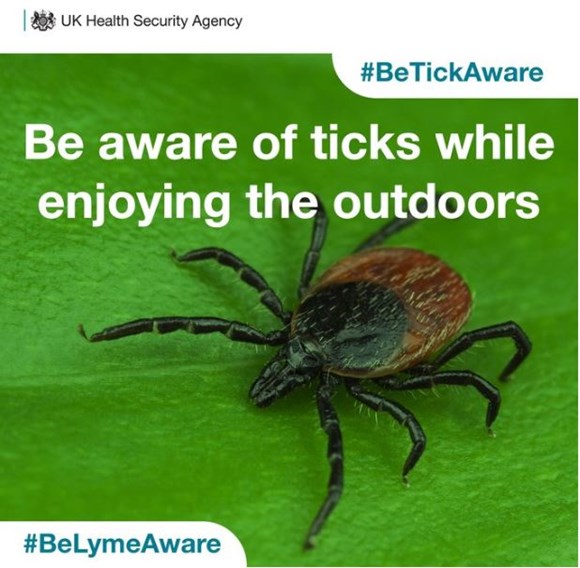As the days get warmer and everything starts bursting into life and colour, we want to get out and enjoy the vibrance nature has to offer, but the UK Health Security (UKHSA) West Midlands wants to remind Moorlands residents why we should all take care to ‘be tick aware’ during spring.
Bryan Mullin, Senior Health Protection Practitioner and member of the UKHSA West Midlands Zoonotic Infections Group, said: “This time of the year is known as ‘tick season,’ (peaking during April to June), when small spiderlike parasites emerge and feed off the blood of animals – and humans – which can cause some people serious illness from Lyme disease.
“Early signs may include mild flu-like symptoms such as fever, headache and fatigue, often accompanied by a characteristic spreading circular ‘bulls-eye rash’ that can appear at the site of the tick bite 1 to 4 weeks later – though not everyone will have this rash, or it could be missed if under the hairline or on part of the body that’s difficult to see. Other symptoms are muscle pain, joint pain, high temperature, chills and neck stiffness; with more severe symptoms including sharp or prickly nerve pains and paralysis of the facial muscles – typically on one side.”
In most cases, Lyme disease can be treated with a 3-week course of antibiotics, however if the disease persists, later symptoms can include:
- pain and swelling in the joints
- problems affecting the nervous system – numbness or pain in your limbs, paralysis of facial muscles, memory problems
- meningitis – inflammation of the membranes surrounding your brain and spinal cord, which causes headaches, neck stiffness and increased sensitivity to light
- heart problems (rare), such as inflammation of the heart muscle (myocarditis) or sac surrounding the heart (pericarditis), heart block or heart failure
Bryan Mullin says there are simple things everyone can do to be tick aware: “Try to prevent tick bites by regularly check clothing and exposed skin for ticks and brush them off immediately. Walk on paths to avoid brushing against vegetation where ticks may be present and consider wearing light coloured clothing with long sleeves and long trousers, so ticks can be spotted and brushed off clothes immediately and have reduced exposure to skin. You can also get insect repellent like DEET, that repels ticks – making sure you follow the manufacturer’s guidance.
“Risk of Lyme disease increases the longer a tick is feeding, so after enjoying outdoor activities, always carry out a thorough tick check to remove ticks promptly – especially checking skin folds, under arms, groins, waistband area, back of the neck and hairline. If you do find a tick, you need to remove it quickly and correctly with a tick removal tool or fine-tipped tweezers, which are very narrow and pointed. Grasp the tick as close to the skin as possible and pull upwards slowly and firmly, without twisting or crushing it. Wash skin with water and soap afterwards and apply antiseptic cream to the skin around the bite.”
If you think you have been bitten by a tick and start to develop flu-like symptoms days or weeks afterwards, or notice the skin surround a tick bite is becoming more swollen with enlarging areas of redness, you should call your GP for evaluation and possible treatment for Lyme disease.
Around 1,500 laboratory confirmed cases of Lyme disease are reported every year in England and Wales, with around 15% acquired overseas. While it is not a huge problem, it can be very debilitating, with some people suffering effects lasting for months or even years – that’s why we should all ‘be tick aware.’
| About ticks
Ticks are very sensitive to temperature and relative humidity, so they need areas of dense vegetation to survive and reproduce. Woodlands, grasslands, moorlands and even urban parks and people’s gardens all provide suitable conditions and a range of hosts – including your family and pets – on which the ticks can feed. As a host brushes past vegetation, a tick will climb on board and after finding a suitable site on the body, will feed continuously for a varying number of days, depending on the size of the tick. After feeding, the tick will detach and drop off, however this might not be the end of the story for the unlucky host. If a tick feeds off an animal infected with the bacteria that causes Lyme disease, that bacteria will remain in the tick for the rest of its life, and this infection can then pass to a human host. Not all ticks cause us problems, in the UK, the species having the biggest impact on human health is Ixodes Ricinus, more commonly known as the sheep, castor bean or deer tick. This is the principle vector for Lyme disease, however not all bites from an infected tick will cause the disease. |
A new risk assessment published by a joint UKHSA/Defra committee has found that tick-borne encephalitis virus (TBEV) is now likely to be present in England. This is based on both human cases and the detection of the virus in ticks in several areas across the country. The virus causes a range of disease – from completely asymptomatic infection, mild flu-like illness, to severe infection in the central nervous system such as meningitis or encephalitis. Symptoms are similar to other causes of meningitis and can include a high fever with headache, neck stiffness, confusion or reduced consciousness. However, risk of TBEV to people in the UK remains very low.
People should seek GP advice if they are unwell after a tick bite – and should seek urgent medical attention if they or someone they know:
Has symptoms of meningitis:
- severe headache
- stiff neck
- pain looking at bright lights
Develops neurological symptoms:
- has a fit (seizure), if not known to have epilepsy
- sudden confusion or change of behaviour
- weakness or loss of movement in arms and legs
- facial dripping, change in vision or slurred speech











